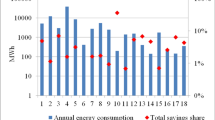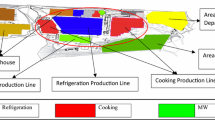Abstract
In 2008, a program was established in Germany to provide grants for energy audits in small- and medium-sized enterprises. It aims to overcome barriers to energy efficiency, like the lack of information or a lack of capacity, and is intended to increase the adoption of energy efficiency measures. We evaluate the program's impact in terms of energy savings, CO2 mitigation, and cost-effectiveness. We find that firms adopt 1.7–2.9 energy efficiency measures, which they would not have adopted without the program. Taking a firm's perspective, the program shows a net present value ranging from −0.4 to 6 €/MWh saved, which very likely implies a net benefit. For the government, each ton of CO2 mitigated costs between 1.8 and 4.1 €. Each euro of public expenditure on audit grants led to 17–33 € of private investment. The cost-effectiveness of the program for firms and the low share of public expenditure underline its value for the German energy efficiency policy mix and suggest that it should be expanded in Germany. Further, the good experiences with the program in Germany should encourage countries which have not yet established an audit program to do so.









Similar content being viewed by others
Notes
German title: "Sonderfonds Energieeffizienz in KMU".
For a more process-oriented assessment of the role of the energy auditors and the regional partners, we refer to Gruber et al. (2011)
Defined as firms with less than 250 employees
This figure also considers omitted firms that did not provide an e-mail address or that objected to data processing. Further, in the case where a firm conducted both audits, it was only asked about the comprehensive audit.
Another approach would be to calculate energy savings based on a comparison of firms’ energy bills before and after the audit. However, due to the relatively low share of energy savings compared to firms’ energy demand, and the fluctuating energy demand as a result of production variation, the success of such an approach is very uncertain. A similar approach, that is, comparing energy bills of audited companies against those of a control group, is hardly possible because of the heterogeneity among firms. Furthermore, we had to rely on a survey and energy audit reports as our main data sources, because metering in firms would have been too costly.
In contrast to the CO2 factor for fuel oil and natural gas, CO2 emissions of electricity generation vary over time, depending on the dynamics in the generation mix. While we are not able to consider hourly variations, the data allows the consideration of annual variations. See Vine et al. (2012) for a more detailed discussion of this aspect.
Question in survey: Was the implementation of measures already planned before the audit?—“certainly planned” (20.9 %), “considered” (42.3 %), “no” (36.8 %)
List of four EEMs not adopted followed by the question in survey: “Do you plan to implement these measures in the near future?”—“certainly” (33.5 %), “possibly” (35.9 %), “rather not” (30.6 %)
Question: “How many measures were recommended in total?” Question: “How many measures did you implement?”
Question in survey: "Would you have conducted the audit even without the program?"—"Yes, with the same level of comprehensiveness" (9.1 %), "Yes, but less comprehensive" (42.6 %), and "No, rather not" (48.3 %).
As the response rate of the control group was very low, we were not able to cross-check this statement by control group comparison.
This mainly results from the fact that many firms consume energy only for building-related end-uses. In this case, single measures like insulation or replacement of heating systems show high impacts when compared to the firm’s total energy consumption.
The weighted mean energy savings are calculated as \( {\text{MeanSaving}}{{\text{s}}^w} = \frac{{\sum\nolimits_{{i = 1}}^n {{\text{Saving}}{{\text{s}}_i}} }}{{\sum\nolimits_{{j = 1}}^m {{\text{EnergyDeman}}{{\text{d}}_j}} }} \) while the nonweighted savings are calculated as \( {\text{MeanSaving}}{{\text{s}}^{\text{nw}}} = \frac{{\sum\nolimits_{{i = 1}}^n {\frac{{{\text{Savings}}_i^j}}{{{\text{EnergyDeman}}{{\text{d}}^j}}}} }}{n} \), where i = EEM and j = firm
Very long payback times are mainly observed for measures related to building renovation (see “Technology characteristics” section).
The corresponding shares of audit costs paid by the company are more than 20 % (initial audit) and 40 % (detailed audit) that were defined as maximum in the program. This is due to the fact that the program provides grants only for 2 days for initial audits and 10 days for detailed audits and several audits exceeded these limits.
Particularly, firms with energy management show a higher share of free riders (15.4 %), whereas this is lower for firms without (7.2 %).
Measured as energy efficiency progress for industry using the ODEX indicator to correct for structural change.
About 42 % of firms used KfW soft loans for financing, while 47 % used own funds and 11 % other types of loans
References
Anderson, S., & Newell, R. G. (2004). Information programs for technology adoption: the case of energy-efficiency audits. Resource and Energy Economics, 26(1), 27–50.
BMWi. (2011). Second national energy efficiency action plan (NEEAP) of the federal republic of Germany, Berlin: Federal Ministry of Economics and Technology (BMWi).
Cahill, C., & Ó Gallachóir, B. (2011). Quantifying the savings of an industry energy efficiency programme. Energy Efficiency. doi:10.1007/s12053-011-9132-8.
Crittenden, P., Lewis, H. (2011). Accelerating the update of energy efficiency in industry—a case study of the Australian energy efficiency opportunities program: ECEEE summer study 2011, June 6–11, Presquíle de Giens.
de Almeida, E. (1998). Energy efficiency and the limits of market forces: the example of the electric motor market in France. Energy Policy, 26(8), 643–653.
de Groot, H. L. F., Verhoef, E. T., & Nijkamp, P. (2001). Energy saving by firms: decision making, barriers and policies. Energy Economics, 23(6), 717–740.
DeCanio, S. J. (1998). The efficiency paradox: bureaucratic and organizational barriers to profitable energy-saving investments. Energy Policy, 26(5), 441–454.
DeCanio, S. J., & Watkins, W. E. (1998). Investment in energy efficiency: do the characteristics of firms matter? The Review of Economics and Statistics, 80(1), 95–107.
DOE. (2011). Impacts: industrial technologies program: summary of program results for CY2009: US Department of Energy.
Dyhr-Mikkelsen, K., Bach, P. (2005). Evaluation of free-of-charge energy audits: ECEEE summer study 2005, May–June, Mandelieu la Napoule.
Eichhammer, W., Fleiter, T., Schlomann, B., Faberi, S., Fioretta, M., Piccioni, N., Lechtenböhmer, S., Schüring, A., & Resch, G. (2009). Study on the energy savings potentials in EU member states, candidate countries and EEA countries. Karlsruhe: Fraunhofer ISI, ISIS, Technical University Vienna, Wuppertal Institute.
European Union (2006). Directive 2006/32/EC of the European Parliament and of the Council on Energy End-Use Efficiency and Energy Services and Repealing Council Directive 93/76/EEC, Brussels.
European Commission (2011). Proposal for a directive of the European parliament and the European Council on Energy Efficiency and Repealing Directives 2004/8/EC and 2006/32/EC, Brussels.
Fleiter, T., Worrell, E., & Eichhammer, W. (2011). Barriers to energy efficiency in industrial bottom-up energy demand models—a review. Renewable and Sustainable Energy Reviews, 15(6), 3099–3111.
Graichen, V., Gores, S., Penninger, G., Wiebke, Z., Cook, V., Schlomann, B., Fleiter, T., Strigel, A., Eichhammer, W., Ziesing, H.-J. (2011). Energieeffizienz in Zahlen, Öko-Institut; Fraunhofer Institut für System- und Innovationsforschung (FhG-ISI) (eds.), Berlin: Umweltbundesamt.
Gruber, E., & Brand, M. (1991). Promoting energy conservation in small and medium-sized companies. Energy Policy, 19(3), 279–287.
Gruber, E., Jochem, E., Mannsbart, W., Roser, A., Ott, V. (2006). Marktstudie Sonderfonds für Energieeffizienz in Industrie und Gewerbe, Karlsruhe: Fraunhofer Institute for Systems and Innovation Research; Institute for Resource Efficiency and Energy Strategies (IREES).
Gruber, E., Fleiter, T., Mai, M., Frahm, B.-J. (2011). Efficiency of an energy audit programme for SMEs in Germany—results of an evaluation study: ECEEE summer study 2011, June 6–11, Presquíle de Giens.
Harmelink, M., Nilsson, L., & Harmsen, R. (2008). Theory-based policy evaluation of 20 energy efficiency instruments. Energy Efficiency, 1(2), 131–148.
Harris, J. (2000). Investment in energy efficiency: a survey of Australian firms. Energy Policy, 28(12), 867–876.
Harris, J., Weston, J., Warr, S., & Peat, A. (1996). An analysis of data from the energy enterprise audit program. Canberra: ABARE.
Harris, J., Anderson, J., Shafron, W. (1998). Energy efficiency investment in Australia, Research Report 98.2, Canberra: ABARE.
Jaffe, A. B., & Stavins, R. N. (1994a). The energy paradox and the diffusion of conservation technology. Resource and Energy Economics, 16, 91–122.
Jaffe, A. B., & Stavins, R. N. (1994b). The energy-efficiency gap—what does it mean? Energy Policy, 22(10), 804–810.
Jochem, E., & Gruber, E. (2007). Local learning-networks on energy efficiency in industry—successful initiative in Germany. Applied Energy, 84(7–8), 806–816.
Larsen, A., & Jensen, M. (1999). Evaluations of energy audits and the regulator. Energy Policy, 27(9), 557–564.
Muthulingam, S., Corbett, C.J., Benartzi, S., Oppenheim, B. (2011). Investment in energy efficiency by small and medium-sized firms: an empirical analysis of the adoption of process improvement recommendations, Working paper: Anderson Graduate School of Management—Decisions, Operations, and Technology Management UC Los Angeles.
Petersson, K., Moberg, J., Björkman, T. (2011). A Swedish success story: how to get astonishing results in energy efficiency due to implementation of a long term agreement with energy intensive industry: ECEEE summer study 2011, June 6–11, Presquíle de Giens.
Price, L., Lu, H. (2011). Industrial energy auditing and assessments: a survey of programs around the world: ECEEE summer study 2011, June 6–11, Presquíle de Giens.
Prognos, EWI, GWS. (2010). Energieszenarien für ein Energiekonzept der Bundesregierung, Projekt Nr. 12/10 des Bundesministeriums für Wirtschaft und Technologie, Basel/Köln/Osnabrück: Prognos AG; EWI;GWS.
Schleich, J. (2004). Do energy audits help reduce barriers to energy efficiency? An empirical analysis for Germany. International Journal Energy Technology and Policy, 2(3), 226–239.
Schleich, J. (2009). Barriers to energy efficiency: a comparison across the German commercial and services sector. Ecological Economics, 68(7), 2150–2159.
Schleich, J., & Gruber, E. (2008). Beyond case studies: barriers to energy efficiency in commerce and the services sector. Energy Economics, 30(2), 449–464.
Sorrell, S., O'Malley, E., Schleich, J., & Scott, S. (2004). The economics of energy efficiency. Elgar: Cheltenham.
Stenqvist, C., & Nilsson, L. (2011). Energy efficiency in energy-intensive industries—an evaluation of the Swedish voluntary agreement PFE. Energy Efficiency. doi:10.1007/s12053-011-9131-9.
Thollander, P., & Ottosson, M. (2008). An energy efficient Swedish pulp and paper industry: exploring barriers to and driving forces for cost-effective energy efficiency investments. Energy Efficiency, 1(1), 21–34.
Thollander, P., Danestig, M., & Rohdin, P. (2007). Energy policies for increased industrial energy efficiency: evaluation of a local energy programme for manufacturing SMEs. Energy Policy, 35(11), 5774–5783.
Thomas, S., Boonekamp, P., Vreuls, H., Broc, J. Sb., Bosseboeuf, D., Lapillonne, B., & Labanca, N. (2011). How to measure the overall energy savings linked to policies and energy services at the national level? Energy Efficiency. doi:10.1007/s12053-011-9122-x.
Vine, E., Hall, N., Keating, K., Kushler, M., & Prahl, R. (2012). Emerging issues in the evaluation of energy-efficiency programs: the US experience. Energy Efficiency, 5(1), 5–17.
Williams, R., McKane, A., Guijn, Z., Nadel, S., Peters, J., Tutterow, V. (2005). The Chinese motor system optimization experience: developing a template for a national program: Proceedings of EEMODS 2005—Energy Efficiency in Motor Driven Systems.
Worrell, E., Ramesohl, S., & Boyd, G. (2004). Advances in energy forecasting models based on engineering economics. Annual Review of Environment and Technologies, 29, 345–381.
Acknowledgments
We would like to thank our colleagues for intensive discussions and their valuable input. We are particularly thankful to Birgit-Jo Frahm, Joachim Schleich, Patrick Plötz, Christian Stenqvist, Christine Mahler-Johnstone and Vicki Duscha as well as two anonymous reviewers. Part of the work was conducted within the framework of a project for the German Federal Ministry of Economics and Technology.
Author information
Authors and Affiliations
Corresponding author
Appendix
Appendix
Rights and permissions
About this article
Cite this article
Fleiter, T., Gruber, E., Eichhammer, W. et al. The German energy audit program for firms—a cost-effective way to improve energy efficiency?. Energy Efficiency 5, 447–469 (2012). https://doi.org/10.1007/s12053-012-9157-7
Received:
Accepted:
Published:
Issue Date:
DOI: https://doi.org/10.1007/s12053-012-9157-7




